After three months of having a great time taking a road trip around the USA, these are the tools we used the most.
First of all, much of this is dependent on having a smartphone, tablet or laptop. Every hotel or motel we stayed at, along with most restaurants have Wi-Fi available. We’ve both got Android phones, but most of these apps have iPhone equivalents.
SIM Cards
First thing you need to do is pick up a cheap monthly PAYG sim card with mobile data. We paid $50 for a card with unlimited everything, and as outlined below, it paid for itself in a matter of days.
SIM cards can be bought in any mobile phone shop, and topped up in almost any convenience shop and supermarket or by using a credit card online.
Compare all the different plans at this useful wiki site. AT&T or Verizon packages were far more expensive, so we bought a T-Mobile sim card. This may have been a mistake as in many remote areas there was no reception. I’d be interested to know if the other mobile providers are as bad in the US.
It’s worth checking whether they allow tethering, as it can be useful when the hotel Wi-Fi is particularly weak. Our mobile plan offered 4G, but the signal was frequently barely 2G, so it’s not really worth paying the extra if you’re not planning on watching streaming videos and the like.
Navigation – Google Maps
We planned a 12,000km road trip using Google Navigation, and other than being a severe drain on the battery it was flawless, especially in the US where the maps are most up to date.
It’s much easier if you use desktop Google maps to add a bunch of waypoints, then on the mobile you can quickly press the waypoint then get directions towards it.
Another useful feature on Google Maps is the ability to cache huge map areas whilst on Wi-Fi, which means you can navigate accurately, even in areas too remote to get a decent data signal.
Restaurants – Urbanspoon & TripAdvisor
Urbanspoon was probably my most used tool after Google Maps. Once you get used to filtering out the numerous suspect/fake one-off reviews you can find some amazing hidden gems. Frequently these were the 5-10th best with the honest reviews rather than the media-savvy higher rated restaurants with a lot of one line, one review entries.
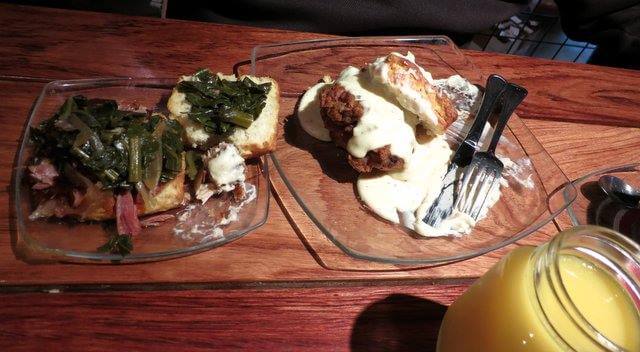
Worth the effort of searching: Serious Biscuit in Seattle – ham hock with collard greens, and fried chicken with gravy
Yelp offers much the same service for all sorts of stores, but is commonly linked to articles about extorting fees in exchange for not highlighting poor reviews.
Opentable is good for making last minute restaurant bookings at busier venues.
Gas/Petrol – Gas Buddy
This app takes your location and lists the 30 lowest fuel prices in the area, either as a list or on a map.
A pattern soon becomes clear, that it’s often worth a 2 minute detour past the first gas station off from the interstate to the next one that’s up to 30c a gallon cheaper. Obviously don’t drive so far for a deal that it costs more than you’ve saved!
A couple that we tried but soon uninstalled were RoadNinja and iExit, which tells you what is at the upcoming road junctions. We found we tended to stop at the cheap gas spot then look for food, rather than the opposite, so it didn’t matter what else was at the junction.
Hotels – Priceline and Hotwire
When we started, we booked the first hotel full price. Looking down the guest list I could see others paying far less than we were. A quick search revealed Hotwire and Priceline, which offer heavily discounted hotels, but don’t tell you which ones until you’ve paid.
The hidden deals are generally great value. I found that the quality of the Priceline hotels was consistently excellent, whilst a couple of the Hotwire deals were slightly run down hotels. Both always gave safe choices in excellent locations.
A large proportion of the Priceline hotels were from the Choice Hotels brand, so ranged from Econolodges to Quality Inns. Hotwire generally had a wider selection and we stayed in older Best Westerns or La Quintas. The Best Westerns in particular were often a little disappointing.
A search on sites like betterbidding.com often reveals the hidden hotels on offer in every city, although it can be outdated in smaller towns.
Once we were confident that the hotels weren’t going to be awful, the restricted choice actually became a huge bonus. Instead of stressing over which hotel in which part of the city to choose, we just selected the best we could get for our budget. This resulted in staying in some unexpected places and led to some great out-of-the-way restaurant finds.
It’s also very satisfying to get a 4* hotel for $45, and see that others have paid $165 for the same size room.
If you’re happy to pay full price, then TripAdvisor will give you user ratings for nearly every hotel. Ignore the one and five star reviews, and look for reviewers with a few reviews under their belt, and you can get a realistic impression.
Visitor Information Centres
For the more traditional recommendations, every state line interstate crossing, most small towns or tourist spots have a visitor information centre (VIC). They hand out brochures, flyers and discounts for their state, and are ideal for finding places that you may never have heard about before.
Discounts are usually good on attractions (10-50% off), but hotels are far cheaper through the apps in the previous section.
The Oregon VIC has an excellent mile-by-mile guide to their main routes. It would be an excellent example for others to follow. Florida’s VIC gives out cups of their famed orange juice and Louisiana had a giant alligator.
The best resource
The best resource is always other people. Chat to people and find out what’s good, fun or new in the area – that way you’ll see and do far more than just the few things listed in the guide books.
Do you know of any other tips and tools we can try next time, either in the US or elsewhere? Alternatively, any useful road trip tips and hacks would be appreciated for an upcoming post.
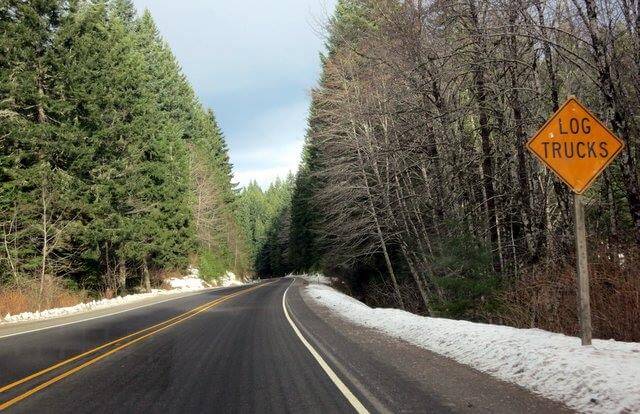
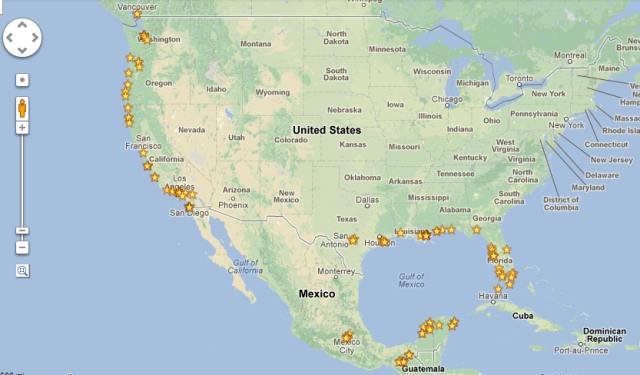
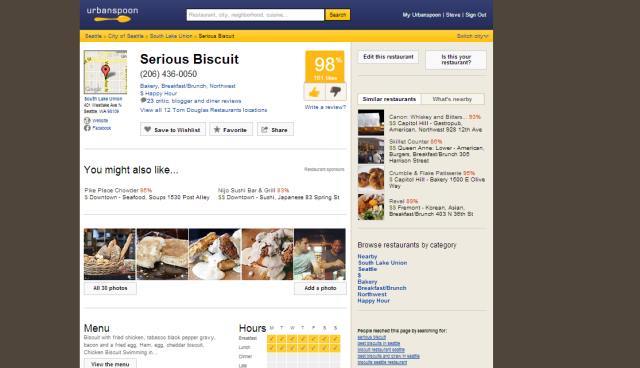
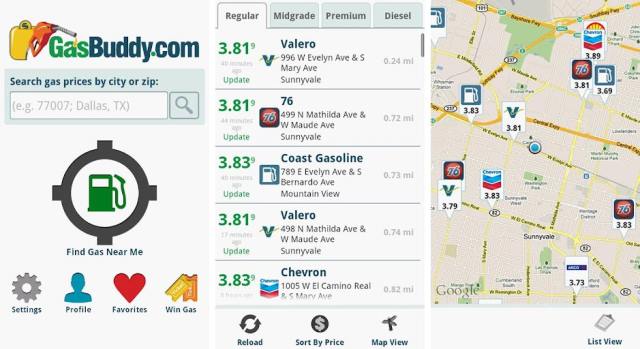
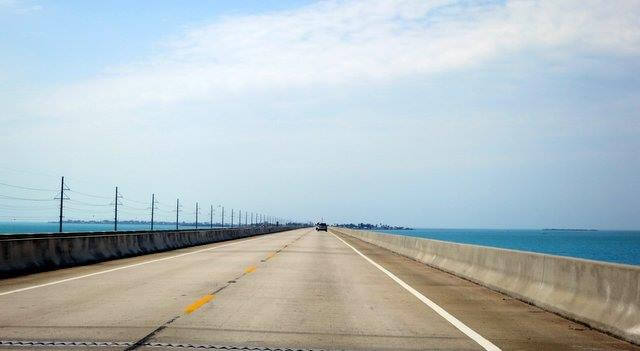











Now THESE are great tips for travel in the new millennium!
BTW, AT&T is pricy but my experience is that they do offer the best coverage.
I use T-Mobile at home on a jail broken iPhone 3GS with no issues but when I was in Montana… UGH!
Verizon was the only carrier that actually worked in Montana (a predominantly rural state with only about 1 million population total statewide) and that made me very sad as Verizon’s software at that time was archaic and in-store customer service was horrible. I hope they’ve realized the error of their systems and ways since then.
The best I’ve ever used was in Cambodia. Never dropped a call, all calls were CRYSTAL clear, and customer service was above par.
Most US provider’s have coverage maps on their website so you’ll be in the know before you go and/or buy.
Thanks again for this post – it’s VERY useful.
Pingback: Maria (@acceleratedstal)
Pingback: Joann Pittman (@jkpittman)
Pingback: @us_meta_guide
T-Mobile is one of the better ones. But like with everything it kind of just depends where you are. I’ve been places where T-Mobile was the only company that had a signal, and elsewhere they were one of the few who didn’t. Ditto for Verizon.
True. We mainly picked T-mobile as at $50/month it was $30 cheaper than the next comparable unlimited package, so can’t complain
Now if only these came for Spain! I just bought a car and couldn’t even get a reliable GPS for my Android, resulting in circling Madrid the wrong way and tacking an extra hour onto my trip. Great round up, S!
Same for the UK – We passed through on the way home and it was a bit disappointing how few reviews there were on Urban Spoon anywhere outside London
Pingback: Cat Gaa (@sunshinesiestas)
Great tips, Stephen. I liked learning of Gas Buddy, since my husband and I will be taking a US road trip this summer.
Another good source of info are the AAA (American Automobile Association) offices. Members get free maps and guidebooks (that also offer good discounts on attractions and lodging). AAA also has reciprocal agreements with auto clubs in other countries, so these can be useful. (In Australia we got free maps and discounts on Lonely Planet guides because of our US AAA membership).
Sadly, you found the best mobile phone deal out there. When I returned to the US from a year-long RTW after buying SIM cards all over the world I was really bummed at my options. TMobile was the only one who even offered the sale of a SIM card. (Everyone else had you buying the phone as well). And agreed, their 4g coverage is not the best–it’s fine in major metro areas, but on the road not so great. 🙁
It’s not obvious at first glance, as Gas Buddy is all about what’s nearby, but there’s a little hidden search box, and you can see what prices are like in other towns.
We did see that AAA members seem to get some great deals all over the place, especially on car hire, but neither of us are eligible for membership. I should check whether the reciprocal agreements go the other way as that would be a good source of discounts.
Pingback: @SayHelloToUSA
Pingback: @BusinessWomenTr
Pingback: Penny Sadler (@PennySadler)
Pingback: @mssackstein
we need to get to serious biscuit. because, i am serious about my biscuits. my brother lives there, how did he NOT TELL ME ABOUT THIS?
love your apps – smart!
The ham hock one is seriously amazing.
Pingback: @CAANEO
Great list. Another good hotel booker is tingo, if you’re booking well in advance. If the cost of the hotel goes down between the time you book and stay, they refund the difference.
That’s a great idea. One I thought about mentioning, but we didn’t really use it enough, was Hotel Tonight. It just finds you a random nearby hotel in a given price range. Nice idea, but I preferred using Hotwire in those circumstances as it guaranteed a few options such as requiring parking or Wi-Fi.
Good tips…I use Urbanspoon quite often. They are also one of the few sites that will post links to blog reviews of particular restaurants.
The blog posts are definitely useful as they hopefully have better photos than those on Urbanspoon
Pingback: @OverlandExperts
Pingback: Green Global Travel (@GreenGlobalTrvl)
Nice post. Very helpful. GasBuddy is a great one. We often use Yelp.com for restaurant reviews in the US. Like other apps you have to take the 5-stars and 1-stars with a grain of salt, but Yelp has led us to great restaurant finds all over the the country. They’ve launched in a few other countries too, but much more limited for now. They’re best for restaurants, but we’ve used the app for hotels, auto service, and other local services as well.